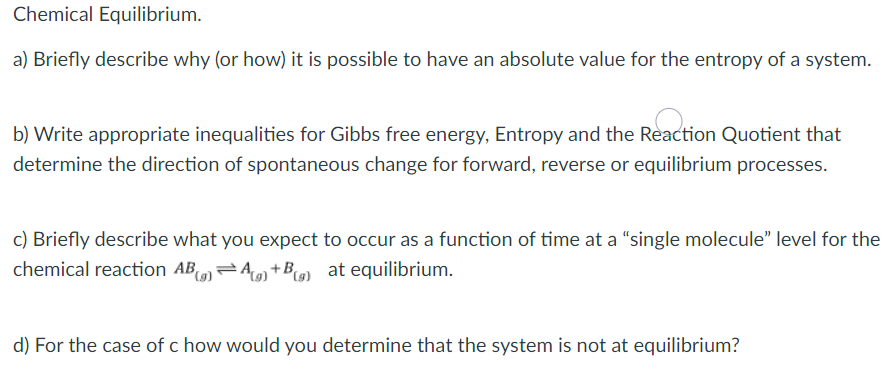Chemical Equilibrium. a) Briefly describe why (or how) it is possible to have an absolute value for the entropy of a system. b) Write appropriate inequalities for Gibbs free energy, Entropy and the Reaction Quotient that determine the direction of spontaneous change for forward, reverse or equilibrium processes. c) Briefly describe what you expect to occur as a function of time at a “single molecule" level for the chemical reaction AB=A +B9) at equilibrium. d) For the case of c how would you determine that the system is not at equilibrium?
Chemical Equilibrium. a) Briefly describe why (or how) it is possible to have an absolute value for the entropy of a system. b) Write appropriate inequalities for Gibbs free energy, Entropy and the Reaction Quotient that determine the direction of spontaneous change for forward, reverse or equilibrium processes. c) Briefly describe what you expect to occur as a function of time at a “single molecule" level for the chemical reaction AB=A +B9) at equilibrium. d) For the case of c how would you determine that the system is not at equilibrium?
Chemistry: The Molecular Science
5th Edition
ISBN:9781285199047
Author:John W. Moore, Conrad L. Stanitski
Publisher:John W. Moore, Conrad L. Stanitski
Chapter12: Chemical Equilibrium
Section12.5: Using Equilibrium Constants
Problem 12.7CE
Related questions
Question

Transcribed Image Text:Chemical Equilibrium.
a) Briefly describe why (or how) it is possible to have an absolute value for the entropy of a system.
b) Write appropriate inequalities for Gibbs free energy, Entropy and the Reaction Quotient that
determine the direction of spontaneous change for forward, reverse or equilibrium processes.
c) Briefly describe what you expect to occur as a function of time at a “single molecule" level for the
chemical reaction AB=A +B9) at equilibrium.
d) For the case of c how would you determine that the system is not at equilibrium?
Expert Solution
This question has been solved!
Explore an expertly crafted, step-by-step solution for a thorough understanding of key concepts.
Step by step
Solved in 2 steps with 1 images

Knowledge Booster
Learn more about
Need a deep-dive on the concept behind this application? Look no further. Learn more about this topic, chemistry and related others by exploring similar questions and additional content below.Recommended textbooks for you

Chemistry: The Molecular Science
Chemistry
ISBN:
9781285199047
Author:
John W. Moore, Conrad L. Stanitski
Publisher:
Cengage Learning

Principles of Modern Chemistry
Chemistry
ISBN:
9781305079113
Author:
David W. Oxtoby, H. Pat Gillis, Laurie J. Butler
Publisher:
Cengage Learning

General Chemistry - Standalone book (MindTap Cour…
Chemistry
ISBN:
9781305580343
Author:
Steven D. Gammon, Ebbing, Darrell Ebbing, Steven D., Darrell; Gammon, Darrell Ebbing; Steven D. Gammon, Darrell D.; Gammon, Ebbing; Steven D. Gammon; Darrell
Publisher:
Cengage Learning

Chemistry: The Molecular Science
Chemistry
ISBN:
9781285199047
Author:
John W. Moore, Conrad L. Stanitski
Publisher:
Cengage Learning

Principles of Modern Chemistry
Chemistry
ISBN:
9781305079113
Author:
David W. Oxtoby, H. Pat Gillis, Laurie J. Butler
Publisher:
Cengage Learning

General Chemistry - Standalone book (MindTap Cour…
Chemistry
ISBN:
9781305580343
Author:
Steven D. Gammon, Ebbing, Darrell Ebbing, Steven D., Darrell; Gammon, Darrell Ebbing; Steven D. Gammon, Darrell D.; Gammon, Ebbing; Steven D. Gammon; Darrell
Publisher:
Cengage Learning

Chemistry: Principles and Reactions
Chemistry
ISBN:
9781305079373
Author:
William L. Masterton, Cecile N. Hurley
Publisher:
Cengage Learning

Chemistry
Chemistry
ISBN:
9781305957404
Author:
Steven S. Zumdahl, Susan A. Zumdahl, Donald J. DeCoste
Publisher:
Cengage Learning

Chemistry: An Atoms First Approach
Chemistry
ISBN:
9781305079243
Author:
Steven S. Zumdahl, Susan A. Zumdahl
Publisher:
Cengage Learning